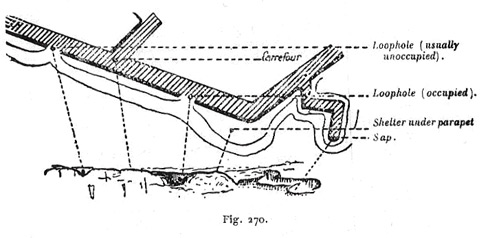Sentry and Look-Out Duty
The following information is taken from the Manuel du Chef de Section d'Infanterie ("The Manual of the Infantry Section Leader"), dated January 1918, and details the proper procedure to be followed at all times for those assigned to sentry and look-out duty at tactical events.
Instructions For Challenging When On Sentry Duty
A soldier assigned to sentinelle ("sentry") duty must maintain a constant state of vigilance. No one is allowed to cross the line of sentries without being challenged by the chef du garde ("chief of the guard"), no matter what their rank, by day and by night. The chef de garde is normally an NCO. Sentries must stop every individual person and/or group passing in their vicinity. Detachments or individuals that are sent out on missions or who otherwise must pass must be accompanied by the chef de garde to the line of sentries. The sentinelle must challenge and be especially vigilant of every detachment or individual coming in from outside of the lines (e.g. no-man's-land) at night. They are allowed to pass only after the chef de garde has recognized the detachment or individual coming in.
To challenge, the sentinelle cries out:
Should this second warning not be heeded, the sentinelle opens fire. If the approaching person(s) stops, the sentinelle summons the chef de garde but does not allow the person(s) to approach. The chef de garde then challenges with the cry:
When the response has been given such as:
"France, soldat [or escouade] du ___ compagnie/regiment."
"France, soldat [or escouade] de patrouille/ronde." ("patrol/round")
Or when the proper signals have been exchanged, the chef de garde cries out:
Once the "mot d'ordre" ("password") has been given, the person(s) may pass. If the person(s) stopped form parts of separate small groups, the chef de garde only allows them to approach one after the other. If a detachment, round or patrol is challenged, it's leader must come forward alone. His troops are kept back at a certain distance until they are permitted to advance, after the leader had been recognized. Even when the "mot d'ordre" has been given in answer to the challenge, the chef de garde must take all possible precautions to verify the identity of the person(s) coming in. Whatever the approach person(s) rank, he must answer all questions presented to him by the chef de garde.
The above procedure is to be done by day and by night.
Challenging of Patrols and Rounds
The sentinelle challenges the patrol or round coming in or passing by as done above, the chef de garde is summoned and requests the "mot d'ordre". Once the patrol or round gives the response, such as:
"France, patrouille/ronde du __ régiment."
Or when the proper signals have been exchanged, the chef de garde cries out:
Once the "mot d'ordre" has been given, the chef de garde responds with the "mot de ralliement" ("counter-sign"). Both words are to be exchanged in a low-voice. They are often superseded by previously agreed upon signals or sounds.
The above procedure is to be done by day and by night.
A simplified print-out of the above procedures can be found here.
Instructions For Look-Outs
SELECTION AND GENERAL INSTRUCTIONS
While any man can fill the role of a sentinelle, not everyone makes a good guetteur ("look-out"). Some are more qualified than others and ability is developed through exercise. The drilling of good guetteurs is one of the most important tasks. Guetteurs must not only be able to see without being seen, but also have the tenacity and patience to observe carefully. Generally, each section had six guetteurs at its disposal of excellent sight and good shots.
The primary purpose of guetteurs is to observe the enemy lines and to establish a "wearing-down fire" to inflict daily losses on the enemy. Guetteurs must always remain alert, especially at night. Sitting is generally forbidden. Standing orders permit the guetteurs to fire-at-will, with generally less strict observation of fire discipline (compared to riflemen not on look-out or sentry duty). As such, they must keep their rifles in their hands at all times, ready to open fire at the least sight or sound of enemy presence or activity. If a suspicious noise is heard out in front of their position, they are authorized and encouraged to open fire. At the same time, while the guetteurs must be quick to fire, they must not fire wildly or waste ammo. If the guetteur is assigned to a forward position such as an advanced outpost or listening post, special instructions may be issued to refrain from firing unless in absolute necessity in order to keep the position hidden from the enemy.
Guetteurs must endeavor to see all that is going on, and to perceive the slightest sign, movement or activity. Standing orders are given to them for the following emergencies:
- Surprise attack, or attack preceded by a bombardment
- Attack preceded by gas attack
- Arrival of shells or grenades
- Special orders pertaining to the specific post
Guetteurs must remain continually at their posts, even under violent bombardments. For a system of observation must be in place at all times in order to allow for a better defense. As a rule, a guetteur is placed close to each troop shelter. Whenever possible, the observation post must be well-installed and fortified to offer the best protection. The guetteur's primary function is to warn when the enemy lengthens his artillery fire and is about to rush the trenches. Officers and NCOs must keep a close eye on the guetteurs to watch for any signs and to replace any who are disabled.
There are two basic types of guetteurs: those that are assigned to watch-over a general area (sector look-out) and those assigned to watch a defined point or feature. The "guetteurs de secteur" observe a clearly defined section of the enemy defenses. The least change in the enemy lines or any indication of the preparation for an attack should be reported to the officer or NCO of the watch. Meanwhile, the guetteurs of defined aiming points observe particular spots which previous observation had made note of activity and upon which one may hope to fire with success. They try as best as possible to observe these spots without being seen, through a narrow and well-concealed loop-hole.
Example of the placement of look-outs.
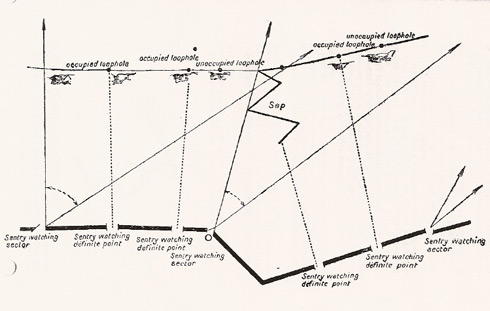
Patient, attentive observation always gives valuable information on the enemy's habits, such as times for reliefs and resupplying. Dust blown up by a shot, or smoke from a cigarette may reveal a loop-hole habitually occupied. It should be inspected with a field glass and a rifle trained upon it. Earth thrown up over the parapet indicates a work party or the construction of a dugout. A small heap of earth and smoke reveals an extant dugout. Study of the sector map and of aerial photographs may allow one to identify on the terrain the intersection of trenches and the most important (and most used) communication trenches. It is always advisable to fire upon these with trench mortars at supposed-times of occupation and heavy traffic.
Guetteurs try to find machine-gun nests, flanking guns, trench mortars, observation posts, etc., and to interpret the least object or unusual sign appearing before them. This information is indispensable when going into the attack, and also to ensure the daily wearing-down of the enemy. When under enemy bombardment, the guetteurs must look through the loop-holes to see the goings-on of the enemy. All means should be used to attract the enemy's attention, drawing him to expose himself: shouting, dummies, simulated fire, placards, etc.
While salients in the first line -- from which a more extended view may be obtained -- are favorable places for observation, guetteurs do not necessarily stand in the first line trenches or in the listening posts. Often points are found more to the rear of these offering an excellent view and calling less attention from the enemy. If there is a lack of time or materials, or if it thought that established observation posts disclose the position, guetteurs will be set up uncovered, their heads concealed behind whatever means of camouflage can be found (brush, grass, logs, canvas or an empty sandbag as a screen, etc.). Another method used was to place an empty sandbag over one's head, with slots cut into it for eye-holes. Guetteurs of the second and third lines are posted near the command posts in order to observe the whole ground and relaying the signals (placards, whistles, flares, etc.) from the first line.
MEANS OF OBSERVATION
All possible efforts should be made to conceal both the observer and his post. In the daytime, observation is done through loop-holes of different shapes (see the French Trench Construction page), or by means of periscopes (see below). A piece of mirror fixed to the end of a stick can also be used to obtain a general view of the enemy trenches if periscopes are lacking. Sector guetteurs normally use loop-holes and periscopes. However, for those watching a certain point, it is often sufficient to bore a circular hole through the parapet with the use of stick or metal tube. Observation with binoculars is possible only if the loop-holes are at least 4" wide.
In order to avoid a changing of light and shadow due to movements behind the loop-hole, a simple remedy on open holes is to stretch a piece of canvas (or even an empty sandbag) behind and over the head of the guetteur (see below). Alternately, a light roof can be constructed (using corrugated metal, branches or logs), with a layer of earth covering it, which lays across the parapet and parados. Similarly, an open, more exposed loop-hole can have an empty sandbag draped over the opening, with the guetteur partially concealing himself while observing.
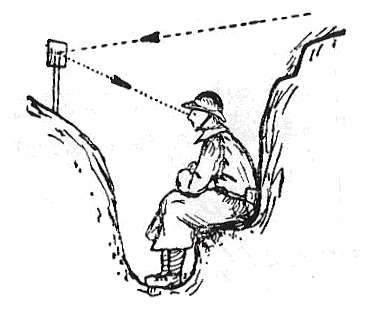
At night, the guetteur is to observe over the parapet. If the emplacement is high enough, the observation loop-hole is placed even with the ground level and the firing step is cut out directly under the loop-hole. At night, the guetteur climbs onto the part of the firing step next to this.
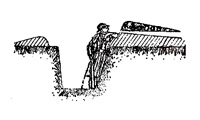
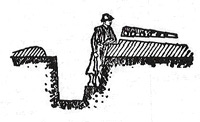
When time and materials were available, observation posts are reinforced, or armored, essentially becoming small sentry boxes built into the trench parapet (on the side closest to the enemy) big enough for one or two men. Sandbags, logs, planks, gravel and iron rails were all employed. Alternately, a less reinforced observation post may simply consist of a steel trench shield which is installed into the parapet. Again, these posts must be made to look as inconspicuous as possible. Observation is made through a very narrow slit (perhaps only a few millimeters big) arranged between two rails, kept apart by small pieces of wood, which can be blocked when not in use.
An observation post should be ideally supplied with the following:
Regarding specifically the observation notebook, it was mandatory for the guetteur to write down his observations. If no notable activity occurred, this must also be noted. If possible, a panoramic sketch of the enemy's positions is made. At prescribed times, an extract of the observation post notebook is made (in a report). The regimental intelligence officer then assembles and discusses all reports. He delivers these to the colonel, along with the "battle map" in 1/5,000 scale.
Example of a panoramic sketch (plan view on the bottom) to be drawn by a lookout and the resulting elevation view that can be deduced from this, in combination with other information.
